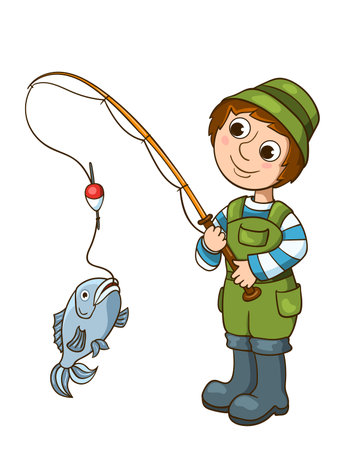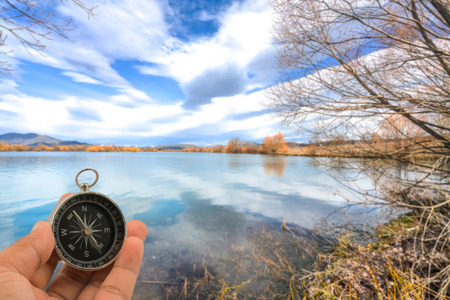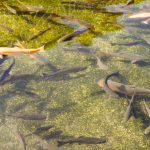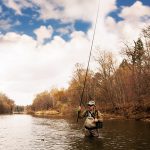1. Understanding Fish Behavior Patterns
When it comes to fishing, timing is everything—and understanding how fish behave throughout the day can make or break your trip. Fish arent biting at random times; their activity is influenced by several key factors like water temperature, feeding cycles, and predator-prey interactions. Let’s break it down so you can hit the water when the fish are most active.
Water Temperature and Fish Activity
Fish are cold-blooded animals, which means their body temperature—and energy levels—are directly affected by the water temperature around them. When the water is too cold or too hot, fish tend to become sluggish and less likely to feed. Most freshwater species have a preferred temperature range where they’re most active and ready to bite.
| Fish Species | Optimal Water Temperature (°F) |
|---|---|
| Largemouth Bass | 65–75°F |
| Trout | 50–60°F |
| Walleye | 55–68°F |
| Catfish | 70–85°F |
Feeding Cycles: When Are Fish Hungry?
Just like people, fish follow natural feeding patterns throughout the day. Many species tend to feed more actively during low-light periods like dawn and dusk. This is often referred to as the “golden hour” for fishing. During these times, fish feel safer from predators and are more willing to roam in search of food.
Common Feeding Times for Freshwater Fish:
- Dawn (sunrise): One of the most productive times as fish begin their daily feeding.
- Dusk (sunset): Another peak period when fish feed before nightfall.
- Noon: Can be slower due to bright sunlight and warmer temperatures, but deeper waters may still hold active fish.
The Predator-Prey Dynamic
Fish behavior is also shaped by their position in the food chain. Predatory fish like bass or pike hunt smaller baitfish, which means their activity will spike when baitfish are moving around. Baitfish typically move more during dawn and dusk as well, making those times great for targeting larger game fish.
Tip:
If you see surface movement or birds diving into the water, that’s usually a good sign that baitfish—and likely predators—are nearby.
By learning how water temperature, feeding habits, and predator-prey relationships influence fish behavior, you’ll be better equipped to choose the best time of day to go fishing. Next up, we’ll dive into how weather conditions affect your chances on the water.
2. Early Morning Magic: Why Dawn Is a Prime Fishing Window
If youre just getting into fishing, one of the best tips you can learn is this: early morning is often the absolute best time to hit the water. Whether youre casting from a dock on a freshwater lake or heading out on a boat in the saltwater flats, dawn offers some serious advantages for anglers of all skill levels.
Cooler Temperatures Keep Fish Active
In the early morning hours—especially during spring and summer—the air and water temperatures are cooler. This is important because many fish species become less active in the heat of the day. Cooler water holds more oxygen, which helps keep fish energized and feeding.
Low Light Makes Fish Less Cautious
Fish tend to be more aggressive and less cautious when its darker. The lower light levels around sunrise make it harder for them to see fishing lines and lures clearly, increasing your chances of getting a bite. Its also an ideal time to use topwater lures, as fish will come up to strike more readily when they feel safe under low-light conditions.
Feeding Frenzy at First Light
Many freshwater and saltwater species are naturally more active during dawn because its their prime feeding time. After a night of rest or reduced activity, fish are hungry and ready to hunt as soon as the sun starts to rise.
Common Species That Feed at Dawn
| Freshwater Species | Saltwater Species |
|---|---|
| Bass | Redfish |
| Trout | Snook |
| Panfish (Bluegill, Crappie) | Speckled Trout |
| Catfish | Striped Bass |
Dawn Conditions Are Ideal for Beginners
If youre new to fishing, early morning trips offer calmer waters and fewer people around. Its quieter, more peaceful, and gives you a better chance to practice casting without distractions. Plus, watching the sunrise while waiting for a bite is one of the most relaxing ways to start your day.
Pro Tip:
Try getting to your spot about 30 minutes before sunrise. That way, youre set up and ready just as the fish start biting.
Overall, if you’re looking for consistent action and an easier learning curve, setting your alarm early can really pay off.

3. Afternoon Lulls and Midday Challenges
Fishing during the middle of the day—especially in the hot summer months—can be tough for beginners. When the sun is high and temperatures peak, many fish tend to retreat to deeper, cooler waters or hide under shaded areas to avoid the heat. This natural behavior can make them less active and harder to catch during midday hours.
But just because it’s a challenging time doesn’t mean you have to pack up your gear. With a little strategy and know-how, you can still make your afternoon fishing trip worthwhile. The key is understanding how weather, shade, and water depth affect fish activity and adapting your approach accordingly.
Why Fish Are Less Active Midday
Most freshwater and saltwater fish are cold-blooded, meaning their body temperature changes with their environment. When the water gets too warm, fish often become sluggish and less interested in feeding. Bright sunlight also makes them more cautious, especially in shallow waters where they’re easily spotted by predators—or anglers.
How to Improve Your Midday Fishing Success
Here are some practical tips that can help you stay productive even when the sun is blazing:
1. Target Deeper Waters
During midday, fish usually move into deeper parts of lakes, rivers, or coastal waters where temperatures are cooler and light penetration is lower. Try using weighted rigs or deep-diving lures to reach these zones.
2. Look for Shade
Trees hanging over riverbanks, docks, bridges, or underwater structures like rocks and fallen logs offer shade that attracts fish looking to escape direct sunlight. Casting near these areas increases your chances of getting bites.
3. Adjust Your Bait and Tactics
Since fish might not be aggressively feeding during this time, switch to slower presentations. Soft plastics, live bait, or drop shot rigs can be more effective than fast-moving lures.
Midday Fishing Conditions at a Glance
| Condition | Challenge | Pro Tip |
|---|---|---|
| High Sunlight | Makes fish seek cover or go deep | Fish near shade or use deeper rigs |
| Hot Water Temps | Reduces fish activity | Target cooler, deeper spots |
| No Wind | Clear water reveals line & bait easily | Use lighter line and natural-looking bait |
| Crowded Waters | More boat traffic disturbs fish | Find secluded coves or quiet banks |
The trick is to think like a fish: if you’d want to cool off in the shade or dive deeper on a hot afternoon, chances are they do too. Keep an open mind and adjust your tactics—you might just turn a slow midday into a surprise success story.
4. Evening Bites: Capitalizing on the Golden Hour
As the day starts to wind down and the sun begins its descent, many anglers find that the hour before sunset—often called the “golden hour”—offers one of the best opportunities for a productive fishing trip. During this time, fish become more active again after retreating during the heat of midday. The drop in light levels, combined with cooling water temperatures, creates favorable conditions that are especially noticeable in spring, summer, and early fall.
Why Evening Fishing Works
Much like early morning hours, the evening golden hour provides cooler water temperatures and lower light conditions that make fish feel more secure as they move closer to shore or shallower waters to feed. Insects become more active around dusk, which in turn draws in baitfish and triggers predatory behavior in larger game fish.
Key Benefits of Evening Fishing
- Lower light reduces fish visibility of lines and lures
- Water begins to cool down from daytime heat
- Increased insect activity attracts baitfish
- Less boat traffic and noise on popular lakes and rivers
Species That Bite Best at Sunset
Certain species tend to be more active during this time of day. Heres a quick look at some common ones:
| Fish Species | Best Time in the Evening | Tactics That Work Well |
|---|---|---|
| Bass (Largemouth & Smallmouth) | 1 hour before sunset until dusk | Topwater lures, crankbaits near cover |
| Catfish | Dusk into nightfall | Stink baits, cut bait on bottom rigs |
| Panfish (Bluegill, Crappie) | Late afternoon to early evening | Small jigs or live worms near structure |
| Trout (in cooler climates) | Sundown to twilight | Dry flies, spinners in moving water |
Helpful Tips for Evening Anglers
- Bring a headlamp or flashlight—sunlight fades fast after sunset.
- Mosquitoes come out strong at dusk; don’t forget bug spray.
- If fishing from a boat, make sure your navigation lights are working.
- Keep an eye on weather changes; storms can roll in quickly late in the day.
The golden hour offers a peaceful and effective time to cast your line. Whether youre targeting bass with topwater lures or waiting for catfish bites as the stars start to appear, evening fishing is not only productive but also one of the most relaxing times to be on the water.
5. How Weather and Seasons Influence Fishing Times
Understanding how the weather and changing seasons affect fish behavior is key to planning a successful fishing trip. Fish are cold-blooded creatures, which means their activity levels are directly influenced by water temperature and environmental conditions. Let’s break down how different weather patterns and seasonal shifts can impact your fishing strategy.
Seasonal Changes and Fish Behavior
Each season brings its own set of challenges and opportunities for anglers. Heres a quick overview of what to expect throughout the year:
| Season | Fishing Behavior | Best Time of Day |
|---|---|---|
| Spring | Fish become more active as the water warms up. Many species begin spawning during this time, making them easier to locate in shallow areas. | Early morning and late afternoon |
| Summer | The heat drives fish to deeper, cooler water during midday. Surface action is often best early or late in the day. | Dawn and dusk |
| Fall | Fish feed aggressively to prepare for winter. Cooler temperatures bring them back into shallower waters. | Mornings and afternoons |
| Winter | Colder water slows fish metabolism. They’re less active but can still be caught with slower presentations. | Late morning to early afternoon (when water is warmest) |
The Role of Real-Time Weather Conditions
Apart from seasons, daily weather has a major impact on fish behavior. Here’s how specific conditions can help or hinder your fishing:
Cloud Cover
A cloudy day usually means better fishing. Without bright sun, fish feel safer venturing into shallow waters to feed. This increases your chances of getting bites throughout the day—not just during dawn or dusk.
Rainfall
A light rain can be great for fishing—it reduces surface visibility, helping you stay hidden from fish. Rain also washes insects and food into the water, attracting baitfish and predators alike. However, heavy rain may muddy the water too much, making it harder for fish to see your bait.
Cold Fronts
This one’s tricky—after a cold front passes through, fishing often slows down. Fish tend to become sluggish and retreat to deeper waters until conditions stabilize. If you’re fishing after a front, try using slower lures and focus on deeper areas where fish may be holding tight.
Tuning Your Strategy Based on Conditions
The more you pay attention to the weather forecast before heading out, the better prepared youll be. Keep an eye on temperature changes, wind direction, barometric pressure, and cloud cover—all of these factors influence when and where fish are likely to bite.
A Quick Tip:
If youre fishing during unstable weather or changing fronts, stick with natural-colored lures and slow retrievals—they tend to work best when fish are wary or inactive.
The bottom line? Matching your timing with seasonal trends and real-time weather gives you a huge advantage on the water. Whether it’s a misty spring morning or a crisp fall afternoon, knowing what makes fish tick in different conditions will help turn your trip into a memorable catch!


